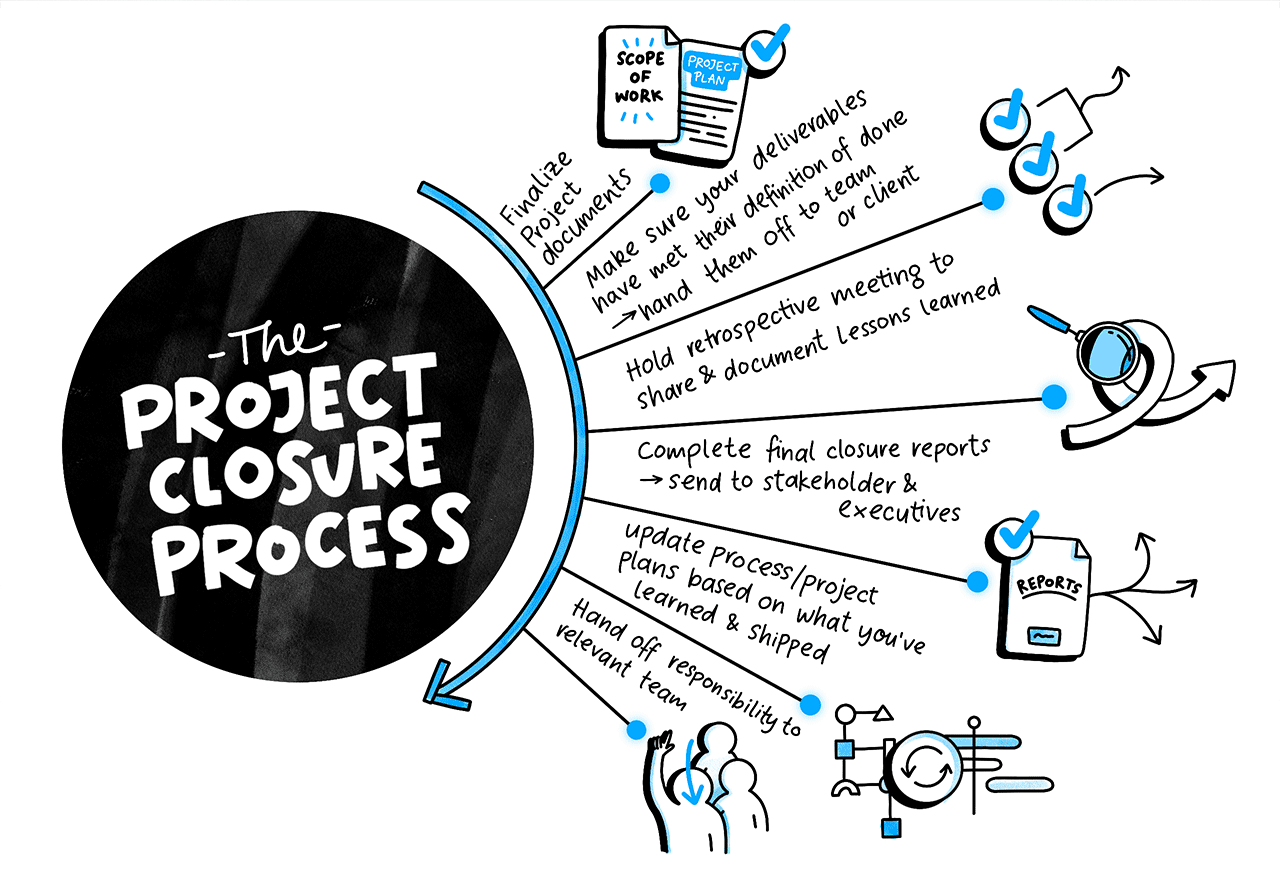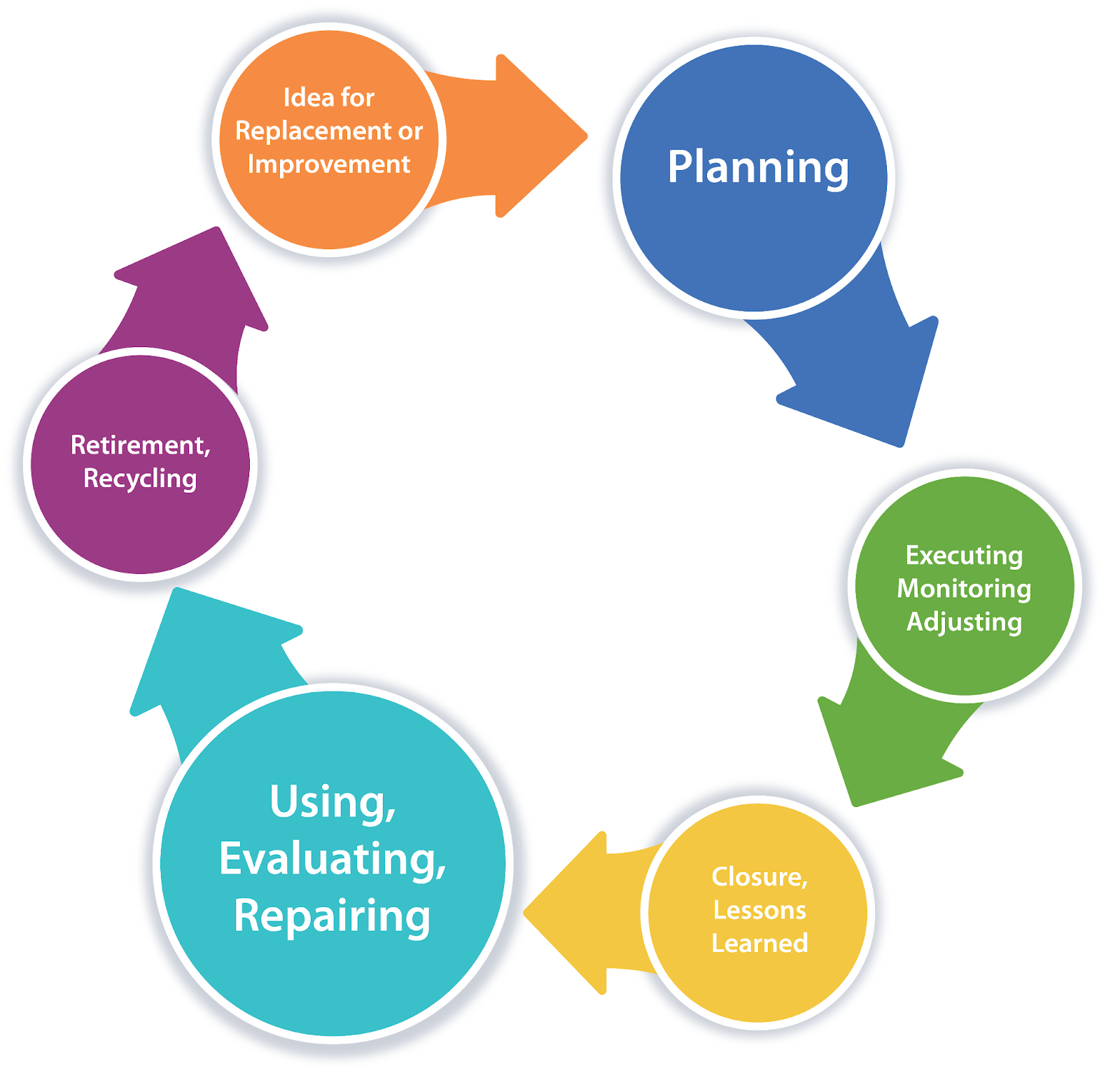Project closeout is the process through which project objectives, project deliverables, project outcomes, and project documentation are reviewed or looked at very carefully and analyzed. It is a critical process in the project management life cycle because it means that the project tasks and achievement of goals set in the project planning and implementation process have been achieved. The essential steps in the project management closeout phase include:
- Reviewing projects for assessment and ensuring that the project goal has been achieved
- Archiving of project documents, and
- Stakeholder sign-off of the project closure.
Introduction to project closeout
The project closeout is the process or stages in which projects are completed. At this stage, all project deliverables have been satisfied, and the project outcome is in line with the intended project goal. This stage undertakes important activities like project reviews and the completion of project documentation.
The project closeout process is a much more in-depth review of the executed and planning phases of the project. This ensures that lessons learned from the projects are documented in favor of future projects. All in all, the project closure offers an organized way of closing out the tasks in the project.
Definition of project closeout

Project closeout encompasses the process of project closeout, that is the finalization of all project tasks, ensuring that the project's deliverables are achieved, and closure of all the documentation related to the project.
The phase of project management closeout denotes the closure of a project; it is intended to evaluate the outcomes of a project to the objectives of the project that were defined in the planning phase of the project.
The phase of project management closeout is further made up of project reviews and learning, which add knowledge for the execution of a future project. The closing processes of the project focus on wrapping everything up so that the project meets its goals without leaving any work in progress.
The importance of Bonsai in project closeout for agency operations
It cannot be overemphasized how vital project closeout is to agency operations. Bonsai provides a centralized platform that aids agencies in efficiently wrapping up projects while ensuring all objectives are met. It serves as the conclusion of the project life cycle. This is where the final deliverables are accepted, the project review completed, and the actual project close-out conducted. This is the project phase at which all work and objectives are finally documented.

Closeout on a project evaluates the outcomes of a project against the project planning process. It enables projects to be thoroughly reviewed so that valid lessons can be learned for use on other projects. Therefore, successful closing processes are essential for continuous improvement and efficient resource management.
By streamlining project management tasks, resource planning, tracking project budgets, and monitoring timelines, Bonsai ensures that the project closeout process is conducted in a timely and orderly fashion.
In essence, Bonsai supports agencies in achieving a comprehensive and effective project closeout, which is crucial for maintaining high standards of quality and client satisfaction, as well as for the strategic growth of the agency.
Understanding of the project closeout process
The project closeout process is the final stage of the project lifecycle, marking the project's completion. This all-important step ensures that the deliverables of the project are delivered, project reviews are carried out, and project documentation is brought to a close. It is an essential process to conduct because it will ensure the project has been delivered and that all the tasks were performed as expected and according to the plan created in the project planning process.
In the project management closeout process, the results of projects are critically analyzed against objectives. It also involves handing over project deliverables to the customer, releasing project resources, and identifying the lessons learned. It is, therefore, true that a systematic closure of the project makes it possible for a successful transition from the execution of the project into business operations.
Project closeout process overview
The project closeout process or the project management closeout phase refers to a process by which all project deliverables are concluded as well as project performance reviewed to identify lessons and success stories. It is the phase that highlights the closure of a project.
Some of the most outstanding tasks in the project closeout process include those that help in finalizing the documentation of the project, meeting the objectives of the project, appraising the outcomes related to the project, and reviews related to the project. They are important tasks in that they help in project planning and project execution for future projects.
Critical steps in the project closing process
Project closing is one of the critical stages of the project life cycle and comprises multiple activities. However the primary activity is to hand over the deliverables to the stakeholders and make sure all the objectives of the project are achieved.
The closing processes also involve a complete analysis of the outcomes of the project and the ones that were planned. These reviews help learn and identify strengths, weaknesses, and areas to improve from these projects. Lastly, one of the most essential activities conducted during the closeout phase of project management is the collection of project documentation in which the planning, executing of the project, and tasks are all recorded as reference for future projects.
Essential steps in project closeout
Project closeout is part of the process that follows in the project life cycle, and it involves the project closure after the achievement of all the project deliverables. It closes the project work and ensures that project documentation is completed. This critical stage should be focused on reflecting on the successful completion of project objectives and the realization of project outcomes.
A detailed review should be done in project closeout as part of the processes for project closing. It is the evaluation of execution versus the project planning. Such reviews extract learning and value addition for the future. Note that a project closeout is not about terminating tasks but closure in an archived way that is learned.
Closing project deliverables
The last process in the project lifecycle is to close out the project and the process during project closeout. It is at this stage that the deliverables of the project are examined for compliance with the initial project objectives and expectations. Activities here are the assessment of the implementation of the project, updating project documentation, and project reviews to explicitly state lessons learned for future planning.
Closeout in project management should be more than the conclusion of project activities; it should encompass formal termination of contracts and release of resources. Careful management during the phase of closeout in project management will guarantee success in the closing processes with the stakeholders' contentment.
All project deliverables and goals will be attained provided effective planning and control mechanisms for the successful delivery of the project are implemented and executed throughout the project's life.
Releasing project resources
The project closure process signifies an ending to the project life cycle and involves releasing project resources. Those resources applied during the project tasks, whether personnel, software, or hardware, are now released and reassigned as appropriate. This allows for minimizing costs and refocusing resources accordingly towards new projects.
As part of the closeout phase within a project management phase, all project documentation is to be updated and properly archived.
Finally, all experiences and outcomes for the team must be recorded to serve as references in future project planning and execution. The other step in the project closeout process is conducting a detailed review of the project deliverables, objectives, and outcomes, which helps in evaluating how successful the project has been and what problems were encountered and need learning from.
Conducting post-project evaluation
Once the project lifecycle reaches the project management closeout phase, a post-project evaluation is key. This step in the project closure process helps to review the project outcomes in relation to the initial project objectives. Specifically, a fine detail of the project tasks, project deliverables, and project execution is done to discern areas of success and failures.
This evaluation follows the project closeout process and culminates the project closure. More than a ceremonial process, it provides the chance to highlight lessons learnt during the project undertaking. Overall, a well-performed post-project evaluation is vital for continuous improvement in project planning.
Documenting lessons learned
The project closure process plays a vital role in the project lifecycle. During the project management closeout phase, it's essential to document lessons learned to enhance future project planning and execution. This involves analyzing project tasks, deliverables, objectives, and outcomes.
Project reviews are undertaken to identify successes and areas for improvement. Documenting these findings assists in improving project closeout processes, boosts team performance on future tasks, and ultimately ensures successful project completion.
Thus, project documentation of lessons learned must be an integral part of the project closure to ensure necessary adjustments and optimizations in future projects.
Archiving project documents
The project completion phase involves various processes including project closeout processes and archiving project documentation. Such documents encapsulate crucial information about the project lifecycle, including project deliverables, project objectives, project planning and project execution results. This information is essential for future project tasks and can be used in project reviews or for reference in new projects.
Archiving project documents is an integral part of the project closure process. The task of thoroughly documenting and storing all project outcomes should not be overlooked. Not only does it help in project management closeout phase, but it is also a necessary step for project closure.
Finally, the project closeout process should ensure that all project documentation is available and adequately stored for future reference. This would help other teams to replicate successful strategies, avoid or tackle potential problems, and contribute to overall improvement of project outcomes.
Role of the project management tools in project closeout

Project management tools play a significant role during the project closeout process. These are aids or tools that help make sure that the required project deliverables are achieved and the project is completed as intended by the project. They provide a systematic approach to dealing with project tasks during the project management closeout phase. They further help finalize the project documentation, which is necessary for the review of projects and assessing the outcome of projects.
With this help in the management of projects, an easy transition can be made from the execution to the closure of projects, making them an inevitable part of the lifecycle of projects. Proper and comprehensive project planning provided by these tools brings better project closing processes into effect.
Using Bonsai for project closeout
The use of Bonsai for the closeout phase of a project is more strategic as it involves the use of features on a reliable platform with regard to task management and collaboration for a hitch-free process. Bonsai tools are utilized for finalizing a project's deliverables, closing pending issues, and documenting project learning.
.webp)
Tools such as Bonsai, therefore, play an essential role in project closeout as far as project management is concerned. They offer a framework to check deliverables that are structured so that all contractual obligations are met, and hence project outcomes are achieved as planned. The feature of being able to add dependencies between tasks quickly, as well as the use of templates on Bonsai, eases the process during closeout. Action items become apparent, hence, for staff to follow.

Besides that, Bonsai's reporting gives insight into how the project performed and helps the team draw lessons from what went wrong and what went right. This helps in closing out the project at hand and coming up with better best practices for future projects. With Bonsai, project closeout can be made comprehensive and practical, marking its end with clarity and precision.
Using Microsoft Project for project closeout
Microsoft Project facilitates the vital project closeout process. It assists in organizing all project documents and tracks the achievement of project deliverables to ensure completion. This tool takes you through each process of how to close a project properly, making sure results and lessons learned are recorded systematically.
Key features of Microsoft Project involve:
- Providing a snapshot of project objectives and goals attained using the project reviews.
- It allows for strategic execution of project tasks since everything is documented in the software.
- Eases project planning for projects yet to be undertaken since all the data for other projects is accessible from previous projects.
Benefits of Asana in project closeout
Asana has proved invaluable in the project closeout process since everything involving the project reviews and project management closeout phase is streamlined. Asana ensures the complete execution of project tasks and alignment of the project's objectives and outcomes. It allows for effective tracking of project deliverables and monitoring project lifecycles. The platform also assists with maintaining project documentation, which reduces the risk of losing essential data during project execution.
Additionally, Asana assists in scheduling reviews after projects, which ensures that there is a smooth project closure and lays the foundation for the planning of future projects.
How Trello supports project closeout
Trello supports project closeout in the sense that it allows for the easy management of completion of work for the project. The program permits having a view of the deliverables and status of the project in detail, allowing for the project lifecycle to be easy and managed.
During the project management closeout phase, Trello can be adopted to store and organize related project documentation for future purposes. To enable a comprehensive review of the project output in relation to the originally intended objectives of the project, for instance, it could be used in subsequent project planning.
Besides, it can use project reviews by facilitating the assessment of project execution and making highlighted learning for future projects. Thus, Trello should be a powerful tool for all processes involved in closing the project.
Common challenges in project closeout and how to overcome them

One of the main challenges in project closeout is ensuring the completion and delivery of all project deliverables. This can be overcome by rigorous project reviews and a solid project closeout process. Another challenge is the collation and organization of final project documentation, which can be mitigated by incorporating documentation as a critical step in the project lifecycle. Lastly, the ambiguity of project outcomes might arise, particularly if project objectives were not clearly defined in project planning. This can be countered with clear project execution and closing processes that align with the project's objectives.
Dealing with unresolved project Issues
The project closure process is a vital stage of the project lifecycle. It's an opportunity to resolve any unresolved project issues to ensure project delivery aligns with the initial project objectives. During this phase, the project closeout process tasks such as the finalization of project documentation and reviews are performed.
Despite the project completion being the end target, the project management closeout phase ensures no loose ends. This includes addressing any outstanding project deliverables, reconciling all project tasks and measuring the final project outcomes against the set milestones during project planning.
Managing stakeholder expectations at closeout
Managing stakeholder expectations at project closeout is a crucial part of the project closure process. It involves accurate status communication of project deliverables, project outcomes, and project completion. This ensures a smooth transition into the project management closeout phase.
An effective project closeout process includes an overview of the project lifecycle, careful review of the project objectives, and meticulous documentation of the project execution. Project reviews focusing on project tasks and overall project planning are also integral.
By diligently following these steps, we can ensure that the stakeholders have their expectations realistically met, and the project closure is successful.
Ensuring complete transfer of deliverables
The project closure process is a crucial phase of the project lifecycle as it ensures the complete transfer of project deliverables. It is the final stage of project execution, marking the official completion of project objectives and tasks.
The project closeout process entails consolidating project documentation and conducting project reviews. This not only allows a thorough assessment of project outcomes against planned objectives but also reinforces the lessons learnt for future project planning.
By conducting an effective project management closeout phase, every detail of the project deliverables is fully transferred, ensuring there is no unfinished business or loose ends at the end of the project.
Best practices for effective project closeout
Effective project closeout commences with a well-defined project closeout process whereby all project deliverables are appraised and addressed. This should be achieved by assessing all the project outputs to confirm that they align with the project's pre-defined goals and recording any deviations. The project management closeout process involves thorough documentation of all the project processes — from project planning to project execution. This project documentation accommodates future project reviews and audits.
At the closure of a project, it is essential to do a debriefing meeting on closing processes with stakeholders and any questions are answered while celebrating the completion of the project.
Close-out planning from inception of the project
Close-out planning should begin as soon as the project starts; that is, from the project inception phase. This involves the implementation of an effective project closeout process where all the project deliverables are completed and documented. Sufficient planning provides for an easy transition into the project management closeout phase.
The key things that should be done in the plan to close the project include summarizing the project closing process, identifying the outcomes of the project, and the purpose of the project. All the project activities should also be appropriately reviewed to determine the carrying out and closure of the project. There should be a complete project closeout done to allow lessons for projects in the future.
Involvement of stakeholders in the closeout process
Involving stakeholders at every level of the project life cycle and more so in the project closure stage is fundamentally vital to the success of the process undertaking.at the closeout stage of project management, all deliverables of the project have been attained, and project documentation is organized together to verify that the project has been closed successfully.
They should participate in the project reviews and could be consulted regarding the discussion on the project outcomes. This will have the effect of ensuring that the objectives were met and would give lessons about the implementation aspect in the achievement of the tasks of the project and the quality of the project planning.
Project documentation updating regularly
Updating the documentation of the project is necessary as a feature of the life cycle of the project. It will ensure that all critical information related to project tasks, objectives, and deliverables is documented correctly and retrievable. This becomes crucial in the closeout phase of project management.
Regarded documentation and its regular reviews bring out transparency in the project's execution and assist in the closure of the project. Well-documented information facilitates a more efficient identification and review of the project outputs; hence, this will be easier during the project closure and, therefore, shall contribute to a smooth project completion.
Conclusion: Successful project closeout and its impact on agency success
In summary, the influence of successful project closeout on agency success is a great one. The project closeout process is one of the most important in ensuring the project deliverables are safe and used in directing the project's completion. It ensures that project documentation is done correctly and helps to assure easy management of the project life cycle.
Finally, steps such as those of the project reviews ensure that there is alignment with respect to the project objectives, which is taken to improve the project outcome. This, therefore, places great emphasis on the project management closeout phase about the successful implementation and completion of tasks in any particular project; it takes a large part in project planning and the fulfillment of objectives by the agency.







